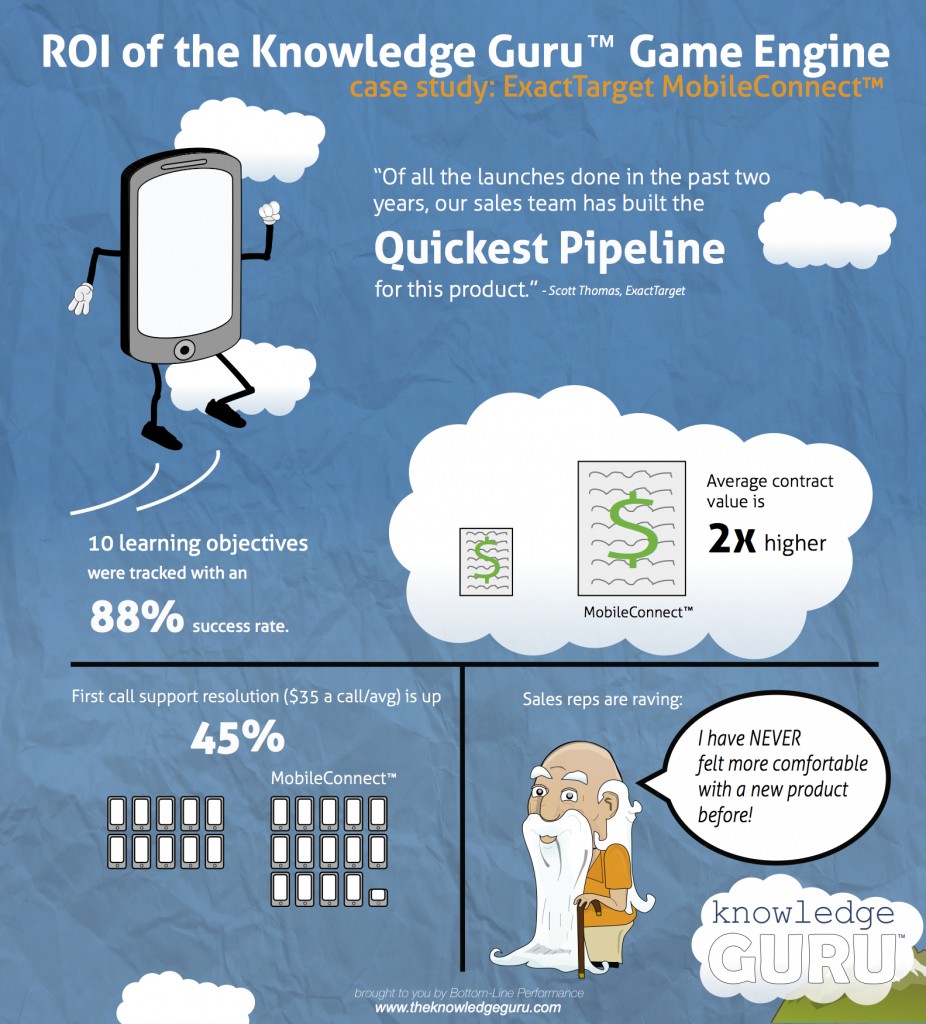What’s the value of a more informed sales rep? What’s the ROI of a more engaged employee? These types of results are hard to quantify, yet they drive meaningful value for a business.
Plenty has been written on the value of games and gamification. Heck, a lot of that has been written by us. But sometimes L&D exists in a vacuum. Sometimes we forget the the primary goal of a corporate learning solution SHOULD be to improve efficiency, minimize mistakes, improve engagement, and maximize ROI.
Without real-life examples, those four buzz phrases sound a whole lot like empty corporate speak. The “ROI” phrase gets tossed around because we think C-Level people like hearing about it. And unfortunately, so many trends and initiatives become so over talked about, so over-used, that they become devoid of meaning. I’m sorry, but we can’t just throw badges and leaderboards into a training course, call it gamified, and head home for the day.
Gamification is not the silver bullet you need to instantly improve your training like some people say it is. We can fully expect many people will grow a bit tired of gamification as too many marketers and yes, employers, start gamifying every single aspect of their lives. “You talked with Kayla about social media. 5 points!”
…But if you implement it well, gamification has major potential to change the way learners interact with your training. Gamification can take a task that would normally be tedious, like memorizing facts about a new product, and make the experience competitive and enjoyable. It can give you better analytics of how your team is really learning, and yes… it can deliver quite a return on your investment. There are still plenty of ways gamification can drive business results within an organization. Here are four examples of results companies saw after implementing training that included gamification elements:
While participating in a gamified training program…
1. Waiters and waitresses improved their level of service to restaurant patrons, resulting in a 1.8% increase in sales for a large restaurant chain.
For so many large restaurant and retail chains, maximizing efficiency at the point of sale can be, well, a crapshoot. The solution for most national chains is to have their wait staff sit through some rudimentary eLearning courses in the back room during their first week on the job, then have them shadow for a shift or two and send them on their way. We can do better!
Not Your Average Joe’s, a 17-unit chain of restaurants located on the east coast of the US, served as the beta tester for Objective Logistics’ Muse, a new mobile gamification software that brings data from customer payments, including tips and surveys, to track employee performance. The top performing employees got a pretty cool prize: they got to pick their own shifts. The result? Average Joe’s saw a 1.8% increase in sales while using the tool.
2. Sales reps doubled the average contract value for a new product.
Regular readers of this blog are already familiar with our Knowledge Guru game engine. The product uses spaced learning and repetition to help players rapidly memorize product facts and industry knowledge. Our friends at ExactTarget used the game to educate employees, partners, and clients on a new product they recently released… and saw some quantifiable results. Sales reps actually doubled the average contract value of the new product versus previous, similar products. By making the process of learning about the product more fun, ExactTarget was able to enable its sales reps to sell better.
3. Employees completed more required training on personal time, improving efficiency during work hours.
No employee is going to tell you they are looking to complete more work-related tasks on their personal time… including me. But what if the training you create is so engaging, employees WANT to do it when they aren’t working? That’s what happened when Deloitte gamified their Deloitte Leadership Academy (DLA). After adding missions, badges, and leaderboards to the training, Deloitte saw a 37% increase in users returning to the site. That means more time spent in training and learning the business… and less time the company needed to invest in expensive instructor led training sessions.
4. Support team members increased first-call resolution of technical support calls by 45%, saving $35 per call.
We often think of ROI as it relates to new sales generated… but the value of a cost-saving initiative can be just as high. ExactTarget was able to create ROI from both angles while using the Knowledge Guru game engine. They opened the game to the support team as well as sales reps, allowing them to compete in the game. The result? Support reps increased first call resolution of technical support calls by 45%. Since each support call costs the company an average of $35, this is a significant cost savings. The infographic below summarizes ExactTarget’s results:

We can sit around all day and talk about the learning science behind effective game based learning and gamification solutions, but we also need to focus on the results these solutions can drive for our organizations. Remember… trying to integrate gamification into a learning solution just because it is a hot trend is not the right answer. You have to know your audience and decide if it will work with them or not. But when you ARE ready to gamify, consider these four case studies a great start for making your business case.


